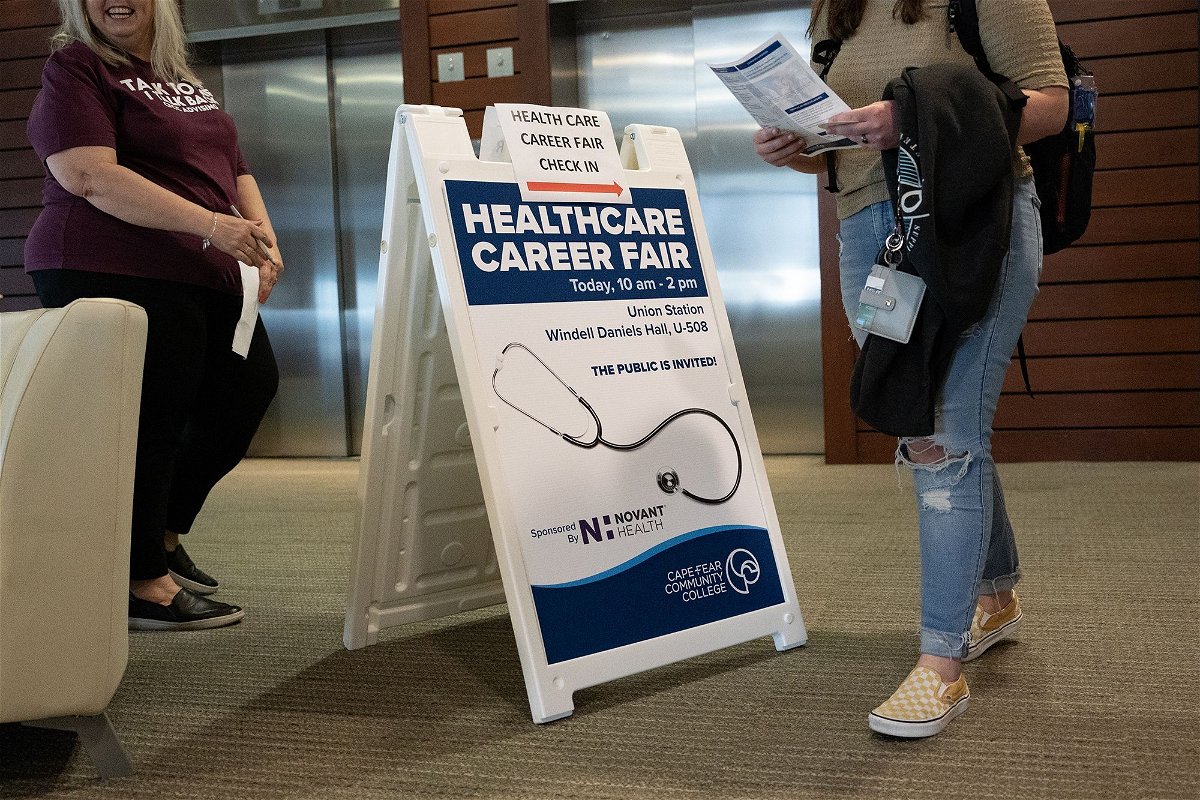The US economy added 339,000 jobs last month, soaring past expectations — again

A sign for a healthcare career fair at Cape Fear Community College in Wilmington
By Alicia Wallace, CNN
Minneapolis (CNN) — The US labor market isn’t ready to slow down just yet.
Employers added 339,000 jobs in May, according to the monthly employment report from the Bureau of Labor Statistics released on Friday.
That’s an acceleration from April’s job gains, which were revised upwardly to 294,000, and it’s a far hotter number than the 190,000 jobs that economists were expecting.
“Overall, the [jobs report and broader economic] data continues to show an economy that’s certainly not in a recessionary mode and perhaps is growing at a healthy pace,” Preston Caldwell, chief US economist at Morningstar, told CNN.
However, the sizable jump in the unemployment rate was also a surprise, rising to 3.7% from 3.4%. Economists polled by Refinitiv had expected it to edge up by only a percentage point.
The surge in the jobless rate — the largest monthly leap since the early days of the pandemic and, before that, November 2011 — was driven by people who lost their jobs permanently and those who completed a temporary job, BLS data shows. The labor force participation rate held steady in May at 62.6%, while the prime age participation rate, for workers between the ages of 25 and 54, rose to 83.4%, which is the highest since January 2007.
That data also shows that it may be taking longer for people to find work: The number of people unemployed for 15 to 26 weeks jumped by 179,000 to 858,000.
Wage growth cooled slightly, with average hourly earnings growing 0.3% the month before and 4.3% over the prior year. Those are respectively down from 0.4% and 4.4% in April.
“As employment reports go, this one was more of a mixed bag,” Mark Hamrick, senior economic analyst for Bankrate, wrote Friday.
Broad job growth
The balmy May jobs report caps off a week of equally toasty labor market data. Job openings bucked a three-month downward trend, climbing back over the 10 million mark; private sector payroll growth blew past expectations for a sharp cooldown; and initial weekly unemployment claims didn’t really budge.
The US economy hasn’t experienced a month of job losses since December 2020, when Covid infections were experiencing a spike.
The May job gains were broad-based, with some of the largest increases seen in professional and business services, government, health care and leisure and hospitality. Construction as well as transportation and warehousing also saw job growth.
“The big jobs numbers come from an economy still rebuilding fundamental services and industries damaged by Covid three years ago,” Robert Frick, economist with Navy Federal Credit Union, said in a statement. “Health care is still hurting for workers after a mass exodus from that profession, and now we continue to see workers returning to that work en masse. We see the same pattern with government and construction jobs.”
Through the first five months of 2023, job growth has averaged 312,000 positions a month. While that’s a pullback from the average monthly net gains of 399,000 jobs and 605,000 jobs seen in 2022 and 2021, respectively, this year’s job growth remains elevated from pre-pandemic times: There were 163,000 jobs added per month in 2019, BLS data shows.
Filling the gaps
In Minnesota, the Minneapolis Park and Recreation Board is having a more successful go so far this year of hiring workers for its vast system of parks, lakes and recreational areas, Rhonda Heryla, the board’s senior human resources consultant, told CNN.
“It feels different this year in trying to get people in the door than it did the last couple of years,” Heryla said.
While some employment gaps persist — for positions such as lifeguards and seasonal park maintenance — the park board has seen some success from not only expanding its outreach efforts (from signage and QR codes to recruitment at high schools) but also from word of mouth.
“We’re looking at whether we could find some non-traditional applicants who might be interested in coming back into the workforce,” she said, “like retirees or folks that may be wanting to work just a few hours but not have a full commitment of 40 hours a week through the summer.”
Those types of jobs include aquatic invasive species inspectors at boat landings as well as golf course positions.
“It seems like if we can get one or two folks, they’ll start to let their friends know about it,” she said.
A tale of two surveys
The monthly jobs report is composed of two surveys to measure employment levels and activity: one that surveys businesses about employment, hours and earnings; and the other of households to obtain the labor force status of the population with demographic details.
The unemployment rate comes from the latter, which is often volatile: The last time (outside of the onset of the pandemic) when the United States saw such a large swing upward in the unemployment rate was in November 2011, when it jumped 0.4 percentage points. In December 2011, the unemployment rate fell 0.5 percentage points, according to BLS data.
“It is not uncommon for these two surveys to tell different stories, but the magnitude of the difference last month was larger than normal and makes the interpretation of what is going on in the job market much more difficult,” Marisa DiNatale, senior director of Moody’s Analytics, noted Friday. “Data released earlier this week showed that the number of job openings rose and the number of people filing for unemployment insurance did not change much and remains low. These are consistent with the payroll survey at least.”
A muddled, mixed bag for the Fed
This is the last jobs report to land before the Federal Reserve meets in less than two weeks to decide whether to raise interest rates for the 11th consecutive time or to pause.
The “mixed bag” jobs report further muddles that decision-making process, noted Olu Sonola, head of US regional economics for Fitch Ratings.
“As the Fed contends with whether to pause, skip or hike at the next meeting, the broader backdrop still reflects a labor market that refuses to crack,” Sonola wrote. “The [June 13 Consumer Price Index] inflation report may provide a bit more clarity, but the rationale for a pause or skip may have just gotten more difficult to articulate.”
Friday’s jobs report also could give license for the Fed to hold pat, Nancy Vanden Houten, Oxford Economics lead US economists, wrote in a note.
“The conflicting data will give the Fed cover to hold policy steady at its upcoming meeting — a pause that’s been well telegraphed — but a resumption of rate hikes in July is a strong possibility if job growth doesn’t slow significantly in June,” she wrote.
The markets appear to agree. While investors are pricing in a 66.1% probability of a pause for the June meeting, they don’t expect that to stick, according to CME FedWatch. US markets have placed a 51.2% probability of a quarter-point rate hike in July.
The-CNN-Wire
™ & © 2023 Cable News Network, Inc., a Warner Bros. Discovery Company. All rights reserved.



